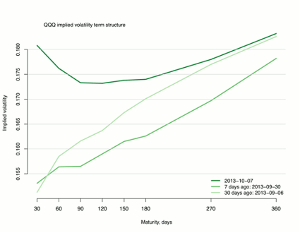Instead of treating the VIX and other measures of volatility as separate entities, Jared Woodard of CondorOptions.com suggests viewing them as bond investors do the yield curve.
Rises in VIX and implied volatility, in general, tend to attract the attention of business reporters and other market watchers who do not usually follow options markets all that closely.I’ve seen several mentions recently, for instance, of the ratio of VIX to VXV as an indication of market stress, and some readers have asked whether I planned to write about this ratio sometime soon. The short answer is that I’ve been writing about VIX:VXV all along.
The ratio of VIX to VXV is one instance of a whole continuum of comparisons that can be made among implied volatility estimates at different maturities. As regular readers will know, VIX measures the implied volatility of options on the S&P 500 index at a constant maturity of 30 calendar days, while VXV provides an estimate of SPX implied volatility at a maturity of 93 days. The most recent addition to the CBOE’s suite, VXST, measures SPX implied volatility at a nine-day horizon.
Instead of thinking about all of these indexes as distinct entities, and about the ratios among them as special statistics to be tracked, investors should think about implied volatility in a similar way to how they think about bond yields, that is, as a curve.
The implied volatility term structure is to options what the yield curve is to bonds. The IV term structure abstracts away from the specific prices of particular option contracts to arrive at a smooth display of the volatility implied by options, in general, as a function of time.
We can focus on narrower slices of the IV term structure by taking estimates at specific maturities and comparing them. VIX:VXV is one such comparison—one month vs. three month implied volatility. VXST:VIX, VXST:VXV, three month vs. six month IV, etc. etc. are others. A chart that shows the full IV term structure can include those maturities and many more.* In that respect, the numerous posts here in recent months about implied volatility term structure are already “about” VIX:VXV, and then some.
One of the good things about short-term indexes is that they are very responsive to changes in the market: an uptick in risk aversion will appear more quickly in something like VXST than it will in options with much more time to expiration; one of the limitations of short-term indexes is that they are also noisy. Not every move in VIX is meaningful. How to find the right balance of responsiveness and meaningfulness is a topic for another post, but I’ll mention that in my own research, I prefer to separate very short-term changes in implied volatility from longer term changes in the term structure. That’s why our risk dashboard tracks VIX and two-month SPY at the money IV—for the short term—but why we look at changes in the longer-term part of the curve – e.g. three-month vs. one-year IV—to note serious shifts in investor risk tolerance.
*CBOE provides an excellent tool for querying VIX term structure data.
By Jared Woodard of CondorOptions.com






















